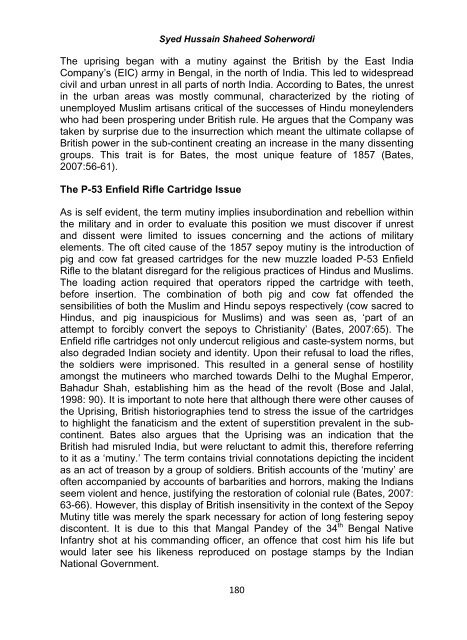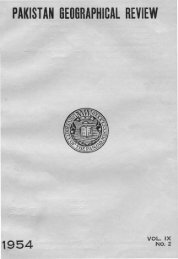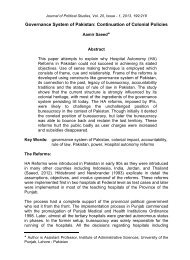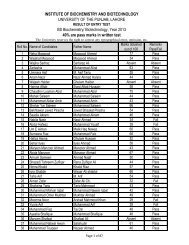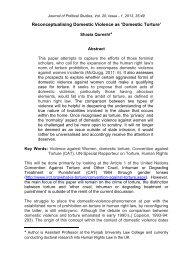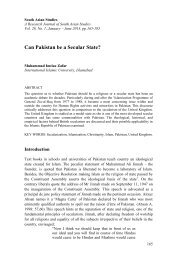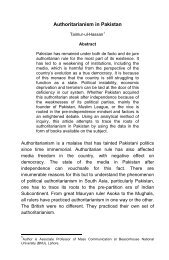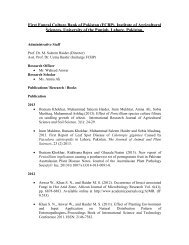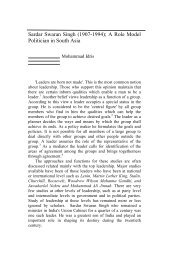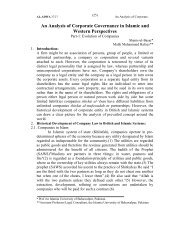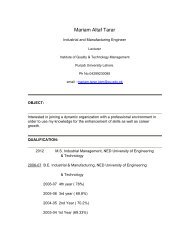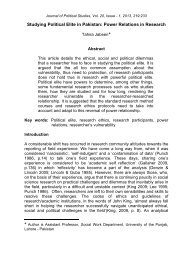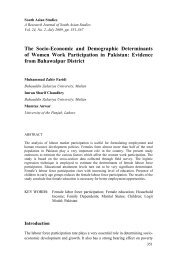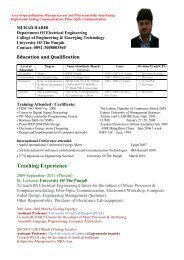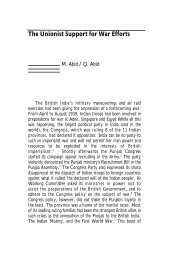The Significance of the Different Names Applied by Historians to the ...
The Significance of the Different Names Applied by Historians to the ...
The Significance of the Different Names Applied by Historians to the ...
Create successful ePaper yourself
Turn your PDF publications into a flip-book with our unique Google optimized e-Paper software.
Syed Hussain Shaheed Soherwordi<br />
<strong>The</strong> uprising began with a mutiny against <strong>the</strong> British <strong>by</strong> <strong>the</strong> East India<br />
Company’s (EIC) army in Bengal, in <strong>the</strong> north <strong>of</strong> India. This led <strong>to</strong> widespread<br />
civil and urban unrest in all parts <strong>of</strong> north India. According <strong>to</strong> Bates, <strong>the</strong> unrest<br />
in <strong>the</strong> urban areas was mostly communal, characterized <strong>by</strong> <strong>the</strong> rioting <strong>of</strong><br />
unemployed Muslim artisans critical <strong>of</strong> <strong>the</strong> successes <strong>of</strong> Hindu moneylenders<br />
who had been prospering under British rule. He argues that <strong>the</strong> Company was<br />
taken <strong>by</strong> surprise due <strong>to</strong> <strong>the</strong> insurrection which meant <strong>the</strong> ultimate collapse <strong>of</strong><br />
British power in <strong>the</strong> sub-continent creating an increase in <strong>the</strong> many dissenting<br />
groups. This trait is for Bates, <strong>the</strong> most unique feature <strong>of</strong> 1857 (Bates,<br />
2007:56-61).<br />
<strong>The</strong> P-53 Enfield Rifle Cartridge Issue<br />
As is self evident, <strong>the</strong> term mutiny implies insubordination and rebellion within<br />
<strong>the</strong> military and in order <strong>to</strong> evaluate this position we must discover if unrest<br />
and dissent were limited <strong>to</strong> issues concerning and <strong>the</strong> actions <strong>of</strong> military<br />
elements. <strong>The</strong> <strong>of</strong>t cited cause <strong>of</strong> <strong>the</strong> 1857 sepoy mutiny is <strong>the</strong> introduction <strong>of</strong><br />
pig and cow fat greased cartridges for <strong>the</strong> new muzzle loaded P-53 Enfield<br />
Rifle <strong>to</strong> <strong>the</strong> blatant disregard for <strong>the</strong> religious practices <strong>of</strong> Hindus and Muslims.<br />
<strong>The</strong> loading action required that opera<strong>to</strong>rs ripped <strong>the</strong> cartridge with teeth,<br />
before insertion. <strong>The</strong> combination <strong>of</strong> both pig and cow fat <strong>of</strong>fended <strong>the</strong><br />
sensibilities <strong>of</strong> both <strong>the</strong> Muslim and Hindu sepoys respectively (cow sacred <strong>to</strong><br />
Hindus, and pig inauspicious for Muslims) and was seen as, ‘part <strong>of</strong> an<br />
attempt <strong>to</strong> forcibly convert <strong>the</strong> sepoys <strong>to</strong> Christianity’ (Bates, 2007:65). <strong>The</strong><br />
Enfield rifle cartridges not only undercut religious and caste-system norms, but<br />
also degraded Indian society and identity. Upon <strong>the</strong>ir refusal <strong>to</strong> load <strong>the</strong> rifles,<br />
<strong>the</strong> soldiers were imprisoned. This resulted in a general sense <strong>of</strong> hostility<br />
amongst <strong>the</strong> mutineers who marched <strong>to</strong>wards Delhi <strong>to</strong> <strong>the</strong> Mughal Emperor,<br />
Bahadur Shah, establishing him as <strong>the</strong> head <strong>of</strong> <strong>the</strong> revolt (Bose and Jalal,<br />
1998: 90). It is important <strong>to</strong> note here that although <strong>the</strong>re were o<strong>the</strong>r causes <strong>of</strong><br />
<strong>the</strong> Uprising, British his<strong>to</strong>riographies tend <strong>to</strong> stress <strong>the</strong> issue <strong>of</strong> <strong>the</strong> cartridges<br />
<strong>to</strong> highlight <strong>the</strong> fanaticism and <strong>the</strong> extent <strong>of</strong> superstition prevalent in <strong>the</strong> subcontinent.<br />
Bates also argues that <strong>the</strong> Uprising was an indication that <strong>the</strong><br />
British had misruled India, but were reluctant <strong>to</strong> admit this, <strong>the</strong>refore referring<br />
<strong>to</strong> it as a ‘mutiny.’ <strong>The</strong> term contains trivial connotations depicting <strong>the</strong> incident<br />
as an act <strong>of</strong> treason <strong>by</strong> a group <strong>of</strong> soldiers. British accounts <strong>of</strong> <strong>the</strong> ‘mutiny’ are<br />
<strong>of</strong>ten accompanied <strong>by</strong> accounts <strong>of</strong> barbarities and horrors, making <strong>the</strong> Indians<br />
seem violent and hence, justifying <strong>the</strong> res<strong>to</strong>ration <strong>of</strong> colonial rule (Bates, 2007:<br />
63-66). However, this display <strong>of</strong> British insensitivity in <strong>the</strong> context <strong>of</strong> <strong>the</strong> Sepoy<br />
Mutiny title was merely <strong>the</strong> spark necessary for action <strong>of</strong> long festering sepoy<br />
discontent. It is due <strong>to</strong> this that Mangal Pandey <strong>of</strong> <strong>the</strong> 34 th Bengal Native<br />
Infantry shot at his commanding <strong>of</strong>ficer, an <strong>of</strong>fence that cost him his life but<br />
would later see his likeness reproduced on postage stamps <strong>by</strong> <strong>the</strong> Indian<br />
National Government.<br />
180


